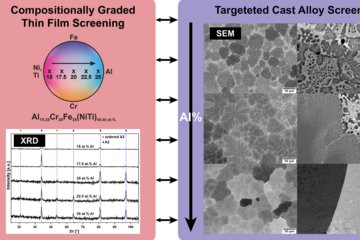All genres
41.
Journal Article
Property-Driven Development of Metallic Structural Materials by Combinatorial Techniques on the Example of Fe–C–Cr Steels. Steel Research International 90 (12), 1900404 (2019)
42.
Journal Article
Light, strong and cost effective: Martensitic steels based on the Fe - Al - C system. Materials Science and Engineering A: Structural Materials Properties Microstructure and Processing 762, 138088 (2019)
43.
Journal Article
Synthesis, microstructure, and hardness of rapidly solidified Cu–Cr alloys. Journal of Alloys and Compounds 794, pp. 203 - 209 (2019)
44.
Journal Article
On the effect of Ni additions to Fe – Cr – B high modulus steels. Materials and Design 167, 107624 (2019)
45.
Journal Article
Synthesis and mechanical testing of grain boundaries at the micro and sub-micro scale. Materialprüfung / Materials Testing 61 (1), pp. 5 - 18 (2019)
46.
Journal Article
Particle-induced damage in Fe–TiB2 high stiffness metal matrix composite steels. Materials and Design 160, pp. 557 - 571 (2018)
47.
Journal Article
Combinatorial metallurgical synthesis and processing of high-entropy alloys. Journal of Materials Research 33 (19), pp. 3156 - 3169 (2018)
48.
Journal Article
Prediction of Martensite Start Temperature for Lightweight Fe–Mn–Al–C Steels. Journal of Phase Equilibra and Diffusion 39 (5), pp. 476 - 489 (2018)
49.
Journal Article
Synthesis and stabilization of a new phase regime in a Mo–Si–B based alloy by laser-based additive manufacturing. Acta Materialia 151, pp. 31 - 40 (2018)
50.
Journal Article
Development of high modulus steels based on the Fe – Cr – B system. Materials Science and Engineering A: Structural Materials Properties Microstructure and Processing 724, pp. 142 - 147 (2018)
51.
Journal Article
Spatially resolved localization and characterization of trapped hydrogen in zero to three dimensional defects inside ferritic steel. Acta Materialia 144, pp. 235 - 244 (2018)
52.
Journal Article
Deformation induced degradation of hot-dip aluminized steel. Materials Science and Engineering A: Structural Materials Properties Microstructure and Processing 710, pp. 385 - 391 (2018)
53.
Journal Article
Nickel-molybdenum alloy catalysts for the hydrogen evolution reaction: Activity and stability revised. Electrochimica Acta 259, pp. 1154 - 1161 (2018)
54.
Journal Article
Stiff, light, strong and ductile: nano-structured High Modulus Steel. Scientific Reports 7 (1), 2757 (2017)
55.
Journal Article
Combinatorial Alloy Design by Laser Additive Manufacturing. Steel Research International 88 (8), 1600416 (2017)
56.
Journal Article
Effect of silicon on the microstructure and growth kinetics of intermetallic phases formed during hot-dip aluminizing of ferritic steel. Surface and Coatings Technology 319, pp. 104 - 109 (2017)
57.
Journal Article
Strengthening Fe – TiB2 based high modulus steels by precipitations. Materials and Design 124, pp. 183 - 193 (2017)
58.
Journal Article
Properties of particle phases for metal-matrix-composite design. Data in Brief 12, pp. 692 - 708 (2017)
59.
Journal Article
Crystallisation of amorphous Fe – Ti – B alloys as a design pathway for nano-structured high modulus steels. Journal of Alloys and Compounds 704, pp. 565 - 573 (2017)
60.
Journal Article
Interstitial atoms enable joint twinning and transformation induced plasticity in strong and ductile high-entropy alloys. Scientific Reports 7, 40704 (2017)











